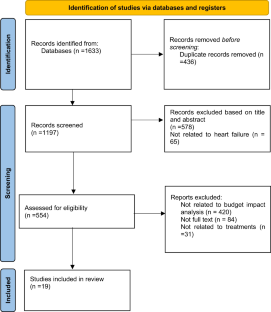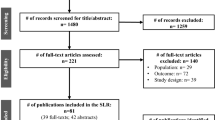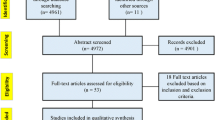Abstract
Heart failure (HF) is increasing globally and turning out to be a serious worldwide public health problem with significant morbidity and mortality. This study aims to systemically review the budget impact analysis of heart failure treatments on health care expenditure worldwide. Scientific databases such as PubMed, Web of Science, Scopus, and Google Scholar were searched for budget impact analysis and heart failure treatments, over January 2001 to August 2023. The quality assessment of the selected studies was evaluated through ISPOR practice guideline. Nineteen studies were included in this systematic review. Based on ISPOR recommendations, most studies were performed on a 1-year time horizon and used a government (public health) or health system perspective. Data for selected studies was mainly collected from randomized clinical trials, published literature, pharmaceutical companies, and registry data. Only direct costs were reported in the studies. Sensitivity analyses were stated in almost all studies. However, studies conducted in high-income countries reported sensitivity analyses more elaborately than those performed in low- and middle-income countries. In many published articles related to the budget impact analyses of heart failure treatment, addition of new treatments to the health system’s formularies can lead to a reduction in cardiovascular hospitalization rates, re-hospitalization rates, cardiac-associated mortality rates, and an improvement in heart failure class, which can decrease the costs of hospitalizations, specified care visits, primary care visits, and other related treatments.

Similar content being viewed by others
Data availability
The data are available from the authors upon reasonable request.
Change history
25 March 2024
A Correction to this paper has been published: https://doi.org/10.1007/s10741-024-10400-2
References
McDonagh TA et al (2021) ESC Guidelines for the diagnosis and treatment of acute and chronic heart failure: developed by the Task Force for the diagnosis and treatment of acute and chronic heart failure of the European Society of Cardiology (ESC). With the special contribution of the Heart Failure Association (HFA) of the ESC. Eur J Heart Fail 24(1):4–131
National Collaborating Centre for Chronic Conditions (Great Britain) (2003) Chronic Heart Failure: national clinical guideline for diagnosis and management in primary and secondary care. Royal College Phys
Tomasoni D et al (2020) Heart failure in the last year: progress and perspective. ESC Heart Failure 7(6):3505–3530
Lin AH et al (2017) Repeat hospitalizations predict mortality in patients with heart failure. Mil Med 182(9–10):e1932–e1937
Armstrong PW et al (2020) Vericiguat in patients with heart failure and reduced ejection fraction. N Engl J Med 382(20):1883–1893
Butler J et al (2020) Clinical and economic burden of chronic heart failure and reduced ejection fraction following a worsening heart failure event. Adv Ther 37:4015–4032
Bui A, Horwich T, Fonarow G (2011) Epidemiology and risk profile of heart failure. Nature Rev Cardiol 8(1):30–41. Epub 2010/11/10. https://doi.org/10.1038/nrcardio.2010.165. PMID: 21060326
Lesyuk W, Kriza C, Kolominsky-Rabas P (2018) Cost-of-illness studies in heart failure: a systematic review 2004–2016. BMC Cardiovasc Disord 18(1):1–11
Tumanan-Mendoza BA et al (2018) Economic burden of hospitalisation for congestive heart failure among adults in the Philippines. Heart Asia 10(2)
Kristin E et al (2022) Budget impact analysis of Sacubitril Valsartan in the Treatment of heart failure and reduced ejection fraction (HFrEF) in Indonesia setting. Indo J Pharm 83–92
Zhang Y et al (2023) Current status and challenges in prenatal and neonatal screening, diagnosis, and management of congenital heart disease in China. The Lancet Child Adolesc Health
Cariou C et al (2017) Budget impact analysis of sacubitril/valsartan introduction for heart failure treatment from the French hospital perspective. Value in Health 20(9):A607
Ponikowski P et al (2016) 2016 ESC Guidelines for the diagnosis and treatment of acute and chronic heart failure. Kardiologia Polska (Polish Heart Journal) 74(10):1037–1147
Piperidou A, Loutradis C, Sarafidis P (2021) SGLT-2 inhibitors and nephroprotection: current evidence and future perspectives. J Hum Hypertens 35(1):12–25
Lin X et al (2022) Cost-effectiveness of empagliflozin as a treatment for heart failure with reduced ejection fraction: an analysis from the Chinese healthcare perspective. J Thorac Dis 14(5):1588
Sul J et al (2016) FDA approval summary: pembrolizumab for the treatment of patients with metastatic non-small cell lung cancer whose tumors express programmed death-ligand 1. Oncologist 21(5):643–650
Trueman P, Drummond M, Hutton J (2001) Developing guidance for budget impact analysis. Pharmacoeconomics 19:609–621
Mauskopf J et al (2017) Introduction to budget-impact analysis. Budget-Impact Analysis of Health Care Interventions: A Practical Guide 1–10
Garattini L, van de Vooren K (2011) Budget impact analysis in economic evaluation: a proposal for a clearer definition. Eur J Health Econ 12(6):499–502
Sullivan SD et al (2014) Budget impact analysis—principles of good practice: report of the ISPOR 2012 Budget Impact Analysis Good Practice II Task Force. Value in health 17(1):5–14
Silva MT, Silva END, Pereira MG (2017) Budget impact analysis. Epidemiologia e Serviços de Saúde 26:421–424
Mauskopf JA et al (2007) Principles of good practice for budget impact analysis: report of the ISPOR Task Force on good research practices—budget impact analysis. Value in health 10(5):336–347
Page MJ et al (2021) The PRISMA 2020 statement: an updated guideline for reporting systematic reviews. Int J Surg 88:105906
Alsumali A et al (2021) Budget impact analysis of vericiguat for the treatment of chronic heart failure with reduced ejection fraction following a worsening event. Adv Ther 38:2631–2643
Bisognano J et al (2021) Cost-impact analysis of baroreflex activation therapy in chronic heart failure patients in the United States. BMC Cardiovasc Disord 21:1–9
Gaziano TA et al (2020) Cost-effectiveness of sacubitril-valsartan in hospitalized patients who have heart failure with reduced ejection fraction. JAMA cardiology 5(11):1236–1244
Borer JS et al (2016) Budget impact of adding ivabradine to standard of care in patients with chronic systolic heart failure in the United States. J Manag Care Spec Pharm 22(9):1064–1071
Smith DG, Cerulli A, Frech FH (2005) Use of valsartan for the treatment of heart-failure patients not receiving ACE inhibitors: a budget impact analysis. Clin Ther 27(6):951–959
Smith DG et al (2007) Estimated cost savings associated with the use of valsartan in heart failure in a large US health plan. J Med Econ 10(3):229–238
Chiong JR et al (2012) Evaluation of costs associated with tolvaptan-mediated length-of-stay reduction among heart failure patients with hyponatremia in the US, based on the EVEREST trial. J Med Econ 15(2):276–284
McEwan P et al (2023) Impact of ferric carboxymaltose for iron deficiency at discharge after heart failure hospitalization: a European multinational economic evaluation. Eur J Heart Fail 25(3):389–398
Gandjour A, Ostwald DA (2018) Sacubitril/valsartan (LCZ696): a novel treatment for heart failure and its estimated cost effectiveness, budget impact, and disease burden reduction in Germany. Pharmacoeconomics 36:1285–1296
Theidel U et al (2017) Budget impact of intravenous iron therapy with ferric carboxymaltose in patients with chronic heart failure and iron deficiency in Germany. ESC heart failure 4(3):274–281
Bourguignon S et al (2019) Budget impact of intravenous ferric carboxymaltose in patients with chronic heart failure and iron deficiency in France. ESC heart failure 6(3):559–569
Delgado JF et al (2020) Budget impact of ferric carboxymaltose treatment in patients with chronic heart failure and iron deficiency in Spain. J Med Econ 23(12):1418–1424
Leong RN et al (2023) Budget impact analysis of utilization of Sacubitril/Valsartan for the treatment of heart failure with reduced ejection fraction in the Philippines. Value in Health Regional Issues 36:105–116
Ratanasumawong K, Piyayotai D, Makarawate P (2022) POSC106 budget impact analysis of including Sacubitril/Valsartan in the national formulary for the treatment of Heart Failure with Reduced Ejection Fraction (HFREF) in Thailand. Value in Health 25(1):S107
Brock E et al (2014) Budget impact of parenteral iron treatment of iron deficiency: methodological issues raised by using real-life data. Eur J Health Econ 15:907–916
Wong B et al (2021) Study of patients with iron deficiency and HF in Ireland: prevalence and treatment budget impact. The British J Cardiol 28(1)
Rognoni C, Gerzeli S (2019) Ferric carboxymaltose for patients with heart failure and iron deficiency in Italy: cost–effectiveness and budget impact. Journal of comparative effectiveness research 8(11):1099–1110
Lorenzovici L et al (2019) Budget impact of intravenous iron therapy with ferric carboxymaltose in patients with chronic heart failure and iron deficiency in Romania. Journal of Cardiovascular Emergencies 5(4):131–139
Niezen MG et al (2009) Finding legitimacy for the role of budget impact in drug reimbursement decisions. Int J Technol Assess Health Care 25(1):49–55
Pearson SD (2018) The ICER value framework: integrating cost effectiveness and affordability in the assessment of health care value. Value in health 21(3):258–265
McCabe N et al (2017) Six-minute walk distance predicts 30-day readmission after acute heart failure hospitalization. Heart Lung 46(4):287–292
Borisenko O et al (2018) An early analysis of cost-utility of baroreflex activation therapy in advanced chronic heart failure in Germany. BMC Cardiovasc Disord 18:1–10
Nakao Y et al (2022) Cost-effectiveness of long-term tolvaptan administration for chronic heart failure treatment in Japan. J Cardiol 79(3):408–416
Dasta JF et al (2018) Economic impact of tolvaptan treatment vs. fluid restriction based on real-world data among hospitalized patients with heart failure and hyponatremia. Hosp Pract 46(4):197–202
Swedberg K et al (2010) Ivabradine and outcomes in chronic heart failure (SHIFT): a randomised placebo-controlled study. The Lancet 376(9744):875–885
Guha K et al (2016) Audit of a tertiary heart failure outpatient service to assess compliance with NICE guidelines. Clin Med 16(5):407
Rueda J-D et al (2020) Limitations and challenges of conducting budget impact analyses in rare diseases: a case study of alpha-1 antitrypsin deficiency. Value in Health Regional Issues 23:70–76
Han L et al (2020) A systematic review of the budget impact analyses for antitumor drugs of lung cancer. Cost Effect Resour A 18(1):1–10
Funding
This work was not supported by any university/institute.
Author information
Authors and Affiliations
Contributions
Conceptualization: Abedin Teimourizad, Abdosaleh Jafari. Project administration: Abedin Teimourizad. Data extraction: Abedin Teimourizad, Abdosaleh Jafari. Quality assessment: Abedin Teimourizad, Abdosaleh Jafari. Analysis: Abedin Teimourizad, Abdosaleh Jafari, Firooz Esmaeilzadeh. Writing—original & editing: Abedin Teimourizad, Abdosaleh Jafari, Firooz Esmaeilzadeh.. All authors read and approved the final version of the manuscript.
Corresponding author
Ethics declarations
Ethics approval
This study does not require official ethical endorsement because it will not include the gathering of primary data.
Competing interest
The authors declare no competing interests.
Additional information
Publisher's Note
Springer Nature remains neutral with regard to jurisdictional claims in published maps and institutional affiliations.
The original online version of this article was revised: In the recently published paper, we regret to inform that Tables 1, 2, and 3 were published without their respective bodies.
Rights and permissions
Springer Nature or its licensor (e.g. a society or other partner) holds exclusive rights to this article under a publishing agreement with the author(s) or other rightsholder(s); author self-archiving of the accepted manuscript version of this article is solely governed by the terms of such publishing agreement and applicable law.
About this article
Cite this article
Teimourizad, A., Jafari, A. & Esmaeilzadeh, F. Budget impact analyses for treatment of heart failure. A systematic review. Heart Fail Rev (2024). https://doi.org/10.1007/s10741-024-10397-8
Accepted:
Published:
DOI: https://doi.org/10.1007/s10741-024-10397-8




